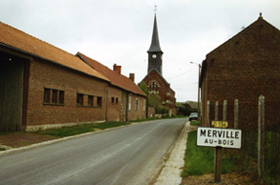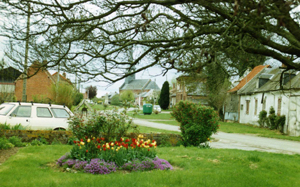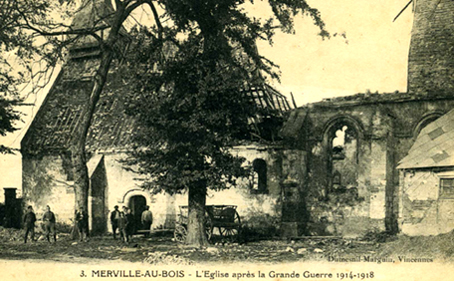Finding Merville
By Jack Hodgins
first published in the Comox Valley Record, vol. 11, no. 44.
(The experience related below, along with a return visit months later -- to this village and to Vimy Ridge -- led eventually to the writing of the novel Broken Ground.)
Two hundred and fifty Parisian readers, publishers, booksellers, and society people (including the French Minister of Culture and the Canadian Ambassador to France) have gathered in the Paris Opera in the Place de la Bastille for the opening evening of Les Belles Etrangeres, a 10-day festival celebrating the literature of English-speaking Canada.
Here they watch an hour-long film about the 10 writers invited to participate. From St. John, New Brunswick, the film moves on to Montreal, to Toronto, to Winnipeg, to Victoria, and then to Merville, B.C.
The outside of the Merville General Store is what they see first. Then, inside, the waitress is cooking up a breakfast of bacon and eggs. Locals come in for their mail and then leave. Men on the bar stools chat. The program booklet informs us that Merville, B.C. was named after a French village by Canadian soldiers who fought there during the First World War. One of the 10 Canadians writers seated in the front row of the theatre grew up in this place.
French film-maker Bruno Moynie has picked me up at my hotel to drive me into the country. He has discovered there are three Mervilles in the world -- two of them in France. One of these is a vague area in the north-west, far from First World War fighting, and the other is two hours north of Paris, near Amiens in Picardy, an area that was in the midst of the fighting during the First World War. The former mayor of this second Merville is execting us.
The road sign points across a shallow valley of ploughed fields and green pastures to a small cluster of trees and roofs. A church steeple. "Merville." Pronounced something like "Mair-VEEY."
A second sign at the edge of the village says "Merville-au-bois," which could be translated roughly as "Ocean-City-by-the Woods". It is a small group of red-brick buildings, with two short streets forming a cross. There is a small church, two public wells with ironwork gates, an abandoned sock factory and no longer used blacksmith shop. |
|
 |
Horses look over the fence in the grassy space between houses. There is a barn on the main street. Cows can be heard bawling. Only a green recycling depot and few parked cars suggest that we haven't returned to the earliest years of the century.
 |
|
Roses and tulips bloom in the front yard of the former mayor of Merville. Monsieur and Madame Dassonville meet us at the door of their house, and invite us in. "You can relax in our modest home," says Guy Dawsonville, in French. "We are just simple peasants around here." |
That there is a Canadian community named Merville is news to him, though he isn't all that surprised. Many Canadians fought in the neighbourhood. Several died here. He asks about this new-world Merville I grew up in. Bruno, who has filmed the place for the literati of Paris, describes it for him -- a general store, a tiny church, several small farms, giant stumps, forest, mountains in the background.
Dassonville is 70 years old, a big man in a sweatshirt with canoeists on the front, and the words "Amazon Winch Contest." He doesn't know what the words mean; it is a fashion now in France to wear shirts with English slogans. He was a farmer until just two years ago, and the mayor until the village was amalgamated with others
There are only two farmers left in the village now. The rest of the population (80 people) are commuters.. Three of the Dassonvilles' four children have moved away, though one lives with their grandchildren at the far end of the village.
He remembers his father telling about the First World War, and has great gouges from German mortar shells in the wall of his house to remind him. The wooden door to the next-door blacksmith shop is a patchwork of little squares covering bullet holes from the Second World War. The fields hereabouts, he says, were fertilized with human bodies. Recently a farmer found a skeleton wearing a Canadian dog-tag somewhere in the nearby woods.

A
postcard photo of the shelled church in Merville-au-bois during the First World War,
with soldiers -- probably Canadian.
The village was the scene of a good deal of fighting during what the French call the Grand Guerre. The inhabitants were evacuated to the west. The nearest trench of the Western front was just a few yards from the buildings. Because the village sits on one of the highest rises in this area of low rolling hills, the Germans shelled it until most of the buildings were ruins. A photograph of the church shows it to be minus most of its roof.
Why was the village named "Merville" or "City by the sea" when it is so far from the ocean? Dassonville listens to this question with amusement in his eyes. He doesn't know, he admits, but adds, "It isn't a city, either."
The Dassonvilles drive us out to visit neighbouring villages and countless war cemeteries. As we pass along the ridge across from Merville, Dassonville indicates the scoop of valley below us. "Down there was the war."
In a nearby Australian cemetery we find rows and rows of Canadian gravestones. Many of these young men died on August 8, 1918, the day of the "big push" when Canadians and others drove the enemy back eight miles -- the beginning of the end of the war.
As we approach Merville again, we swing off the road and along below the grove of trees at the end of the village. In amongst those small trees are remains of the trenches. The depressions have largely filed in with 80 years of falling leaves, and yet you can see how they zig-zag along the slope. Dassonville explains, using body language, that the trenches were dug in a zig-zag pattern so that the enemy could not get into the trench and shoot the entire army lined up in a convenient straight row.
Why would the soldiers who settled on Vancouver Island have felt a strong enough attachment to this place to name their new home after it? I wish I had thought to ask this of John Beeton while he was still with us, or Andy Barr, or James Mathers. Beeton gave me my first taste of plug tobacco off the end of his jack-knife; Barr once told me about digging the Panama Canal; Mathers had been a Staff Sergeant in the Canadian Engineers Tunnelling Company. But I don't recall hearing them talk of the war.
According to one entry in the book "Merville and its Settlers" the name was chosen to honour "a French village, dear to the hearts of many returned soldiers." (Marjorie Lever)
So, standing in the midst of this village, I can only guess at reasons. Perhaps some of them had spent time in the nearby trenches and found the abandoned buildings to be places of relative safety and warmth when they weren't fighting. Maybe some of them found comfort in the ruined church. Or drank milk from a left-behind cow. Or struck up a friendship with a local farmer who may have crept back at night to check on his home.
At the end of the short street, beside the abandoned sock factory, we look across the green fields that scoop down and then up to another village (Moreuil) across the valley. "Here was France," says M. Dassonville, indicating the ground beneath our feet. "There was Germans." With that narrow stretch of No Man's Land in mind, I have no trouble seeing the red brick buildings of Merville-au-bois as places of temporary privacy and shelter for soldiers weary of the crowded life below ground. Perhaps when they named their new settlement they were evoking memories of brief rough shelter in that home away from home.
When we are about to part at the end of the day, Dassonville gives me a rusted copper WWI mortar shell he ploughed up in his field. He has plenty more. Once, he found a bayonet, he says. The sheath was a mass of rust blisters but the bayonet itself, when he pulled it out, was as shiny as new.
He offers to get me some dirt as well, to sprinkle on Vancouver Island, but I imagine Customs officers accusing me of importing French bugs to ruin Comox Valley crops.
Dassonville, expressed admiration for Canadians. When we were about to part, he told me that a nearby village had been twinned with a town in Australia, and wondered if a twin-city arrangement might be made with Merville, B.C. Even if we should find out one day that the Returned Soldiers who cleared the land between Grantham and Black Creek had meant to honour the Other Merville for some reason, this small village just south of the Somme has about it a feeling so reminiscent of the place I grew up in that some sort of friendly arrangement between the two seems appropriate. As I talked with this kindly ex-farmer and ex-mayor of Merville-au-bois, I thought of any number of Merville farmer-loggers who could easily have settled in and found a way of talking with this man. In many ways, they speak the same language.